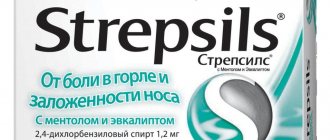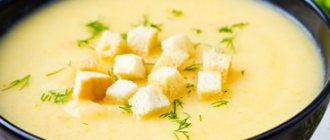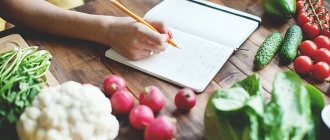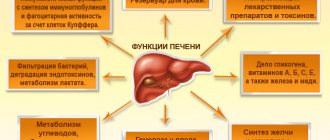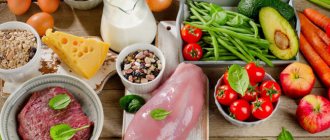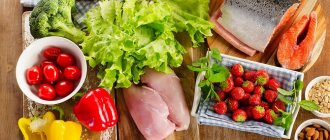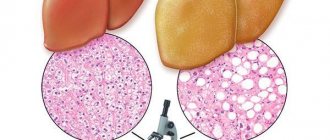General rules
Diseases of the hepatobiliary system are represented by a wide range of diseases of the liver, gall bladder and biliary tract. The main ones include: acute/chronic hepatitis (viral, toxic), liver cirrhosis , alcoholic/non-alcoholic fatty liver disease, liver neoplasms (cancer, abscess, cyst), inflammation of the bile ducts, acute/chronic cholecystitis , cholangitis , cholelithiasis , dyskinesia of the gallbladder/biliary tract.
The hepatobiliary system is a complex multi-level mechanism that is actively involved in both the processes of digestion and metabolism (removal of metabolic products from the body). The result of a violation of its functions is a disruption of detoxification , metabolic processes, and immune response/antimicrobial protection.
Diet for diseases of the gallbladder and liver is an essential component of the treatment process. When prescribing a diet, the nature of liver damage (organic changes, inflammation), the stage of the disease and the patient’s condition are taken as a basis. The main goal of a diet for diseases of the organs of the hepatobiliary system is to spare them as much as possible, restore the structure/function of the liver and provide the patient’s body with a physiologically complete amount and ratio of food nutrients. For functional disorders of the biliary tract, treatment and diet are aimed at eliminating spasm of the sphincter of Oddi and normalizing the motor/evacuatory function of the biliary tract.
The basic diet for diseases of the liver and biliary tract is therapeutic nutrition within Table No. 5 / its varieties with dietary adjustments taking into account the type, form and specific course of the disease. In the acute period of diseases ( acute hepatitis , cholecystitis , exacerbation of chronic forms of these diseases), as a rule, Diet 5A , which ensures maximum sparing of the liver and normalization of function and bile ducts. Great importance is paid to diet.
It is advisable to eat food at the same time, 5-6 times in small portions. This is extremely important, since the body begins to secrete digestive juices at the usual time for eating, and irregular food intake at large intervals leads to a concentration of bile in the gallbladder, caused by the reabsorption of part of the water from the bile. Accordingly, when bile stagnates, a precipitate falls out of it, which serves as the basis for the formation of stones. In addition, regular food intake regulates the emptying of the gallbladder/ductal system.
Outside the acute period of illness, the best option for the gallbladder and liver is Diet No. 5 . In general, the diet is limited to fats, mainly animal fats, simple carbohydrates and salt (up to 10 g). The energy value of nutrition in patients with chronic hepatitis/chronic calculous cholecystitis is selected individually and can vary from 1800-2000 calories for elderly patients to 2800 kcal/day for middle-aged patients with an active lifestyle.
At the same time, it must be taken into account that an imbalance of basic food nutrients has an adverse effect on liver function. The diet should contain foods rich in protein at the rate of 1.2-1.5 g/1 kg of weight/day, while preference should be given to complete animal proteins that prevent the deposition of fat in the liver (lean veal, egg whites, cottage cheese, lean varieties of freshwater fish, cereals: buckwheat, oatmeal).
The total amount of fat should not exceed 1 g/1 kg of weight during the day. Preference should be given to vegetable fats containing polyunsaturated fatty acids, which activate lipolytic enzymes that help normalize fat metabolism/prevent fatty liver. It is not recommended to include foods rich in cholesterol in your diet: brains, internal organs of animals.
Fatty, smoked and fried foods, spicy seasonings, sauces, meat/fish broths, smoked foods, canned food, carbonated drinks, and alcohol should be excluded from the diet, as they contribute to spasm of the sphincter of Oddi.
The amount of carbohydrates in the diet is limited moderately, at the rate of 2-4 g/per 1 kg of weight/day. Excessive consumption of carbohydrates is converted into fat and deposited in the liver, thereby weakening its function. Easily digestible carbohydrates (sweets, jam, sugar) are excluded/sharply limited from the diet, as they contribute to bile stagnation. Preference should be given to foods containing complex carbohydrates.
When compiling a diet, you should take into account the effect of certain products on the motor function of the gallbladder/bile tract. Thus, for hypotension of the gallbladder, it is recommended to consume weak meat/fish broths, soft-boiled eggs, sour cream, cream, vegetable oils (2-3 times a day, a teaspoon 30 minutes before meals).
In the hypokinetic form, it is recommended to drink mineral waters of medium mineralization 30 minutes before meals (200 ml 3 times a day). With the hyperkinetic type of dysfunction, you should sharply limit in your diet foods that stimulate gallbladder contraction (vegetable oils, rich meat/fish/mushroom broths, animal fats). For the hyperkinetic form, still/lightly carbonated waters of low mineralization (2-5 g/l) are indicated, 3-4 times a day, 100-150 ml 1 hour before meals, warm.
Since a number of diseases (chronic hepatitis/ cholecystitis ) are accompanied by frequent constipation, the diet for the gallbladder and liver in such cases involves the introduction of foods containing a lot of fiber into the diet - vegetables, especially beets, fruits (prunes, dried apricots), cereals, seed products, oatmeal bran. If it is necessary to enhance the process of bile secretion, vinaigrette/salads seasoned with vegetable oils (unrefined) should be introduced into the diet.
Therapeutic nutrition for a number of liver diseases (fatty hepatosis) in obese /overweight individuals should be aimed at normalizing weight. To do this, subject to the general principles of dietary nutrition in Medical Table No. 5 , the energy value of the diet is adjusted depending on body weight exceeding the norm, age, gender, and level of physical activity.
In general, for effective and safe weight loss, the calorie content of the diet should be reduced by 500-600 kcal/day from the physiological norm. A higher rate of weight loss is associated with a high risk of developing “acute” steatohepatitis with subsequent formation of fibrosis . Such patients benefit from weekly fasting days: milk with crackers, kefir-curd, apple, fruit and berry (according to the season). Complete fasting with a diseased liver is strictly contraindicated, as it increases metabolic disorders.
Treatment of liver diseases in most cases requires the inclusion in the diet of additional foods that have a hepaprotective effect - artichoke (leaves), pumpkin seeds/oil, licorice, milk thistle oil, St. John's wort. If it is not possible to take them in their natural form, it is recommended to take medications based on them - Artichoke extract , Tykveol , Karsil , Silimar , Gepabene , Legalon , Hofitol , Peponen , Cynarix , as well as hepaprotectors of animal origin - Progepar , Erbisol , Hepatosan , which are quite effective for alcoholic hepatosis , hepatitis , cirrhosis .
In most cases, phospholipids ( Essliver Forte , Phosphogliv ), which, being integrated into the structure of liver cells, reduce energy costs of the liver/restore the cell wall, as well as fatty acids ( Ursofalk , Ursosan , Ursodez , Ursoliv ) are also prescribed. Amino acid derivatives ( Heptor , Heptral ), dietary supplements ( LIV52 ), liver preparations, immunomodulators ( Velferon , recombinant interferons ) also have similar restorative/detoxifying properties.
If it is necessary to increase the secretion of bile/reduce its viscosity, herbal preparations such as corn silk , convaflavin , flakumin , berberine ; the effect is due to the properties of the essential oils, flavones, phytoncides, and resins they contain. In general, hepaprotectors form the basis of basic therapy during exacerbations and have a supporting effect during remission.
Diet "Table No. 5"
Indications*
- chronic cholecystitis;
- cholelithiasis without exacerbation;
- liver cirrhosis (without decompensation);
- chronic hepatitis, acute hepatitis at the recovery stage;
- 14-17 days after removal of the gallbladder;
- not severe toxicosis during pregnancy.
*without significant diseases of the stomach and intestines.
Cooking rules
Maintaining the temperature regime of consumed food in the range from 20 to 60 degrees. Cold and too hot dishes are undesirable for diseases of the liver and bile ducts. You don’t have to chop or grind everything; a lot of it can be eaten in whole pieces.
Recommended diet
Bread products:
wheat bread made from 1st and 2nd grade flour, rye bread made from sifted and peeled flour, baked yesterday or dried, unsweetened cookies.
Cereals and pasta:
rice, buckwheat, oatmeal, well boiled, boiled pasta.
Milk and dairy products:
low-fat milk, fresh yogurt, kefir, cottage cheese (low-fat or low-fat) up to 200 g per day.
Mild, low-fat cheese is allowed in small quantities. Soups:
vegetarian soups with pureed vegetables, puree and cream soups, milk soups half and half with water.
First courses with well-cooked cereals (rice, oatmeal) and finely chopped potatoes, carrots, and pumpkin are allowed. Meat and meat dishes:
boiled or steamed lean meats without tendons and fascia, beef, veal, rabbit, chicken, turkey.
The poultry is consumed without skin. Fish and fish dishes:
low-fat varieties of fish - boiled, steamed or in the form of cutlets.
Vegetables:
potatoes, carrots, beets, cauliflower, greens, pureed, boiled, steamed (mashed potatoes, souffle, etc.) and raw.
Eggs and egg dishes:
steamed and baked egg white omelettes.
When preparing an omelet, it is recommended to use ½-1 yolk and 1-2 whites. Appetizers:
fresh vegetable salads with vegetable oil, fruit salads, vinaigrettes, squash caviar, jellied fish (after boiling), soaked, low-fat herring, stuffed fish, seafood salads, boiled fish and meat, doctor's sausage, milk sausage, dietary sausage, low-fat ham, mild, low-fat cheese.
Berries and fruits:
ripe, soft, sweet fruits and berries (except for sour varieties) in raw natural or mashed form, baked, boiled.
Jelly, jellies, and mousses are also prepared. Dried fruits are consumed pureed. Sweets:
sugar, honey, jam, marmalade (up to 70 g per day), milk and fruit jelly.
Drinks:
weak tea with lemon, milk, weak coffee with milk, sweet fruit and berry juices, compote, rose hip decoction.
Foods and dishes that need to be excluded
Bread products:
fresh bread, puff pastry and pastry, fried pies.
Cereals and pasta:
lentils, peas, beans (except green beans), pearl barley, corn and barley grits, sesame.
Milk and dairy products:
6% fat milk, cream, fermented baked milk, sour cream, full-fat cottage cheese, salty, fatty cheese.
Soups:
meat, fish and mushroom broths, okroshka, salted cabbage soup.
Meat and meat dishes:
fatty meats, duck, goose, liver, kidneys, brains, smoked meats, most sausages and all canned meats.
Fish and fish dishes:
fatty fish, smoked and salted fish, canned fish.
Vegetables:
spinach, sorrel, radish, radish, green onions, garlic, mushrooms, all legumes, pickled vegetables.
Eggs and egg dishes:
fried eggs;
whole egg dishes. Snacks:
spicy and fatty snacks, caviar, smoked meats, canned food.
Berries and fruits:
any nuts and seeds (except flax), raw berries and fruits, ginger, grapes, citrus fruits.
Sweets:
products with cream and chocolate, halva, kozinaki, desserts with seeds, almond flakes, sesame seeds, nuts, condensed milk, hematogen, chocolates and muesli bars.
Drinks:
alcohol, coffee, chicory, carbonated drinks, cocoa, hibiscus and green tea, store-bought juices, cold drinks.
Sample diet menu No. 5 for a week
Monday
- 1st breakfast: cottage cheese with sugar and sour cream, oatmeal porridge with milk, tea.
- 2nd breakfast: baked apple.
- Lunch: vegetarian vegetable soup with vegetable oil, boiled chicken in milk sauce, boiled rice, dried fruit compote.
- Afternoon snack: rosehip decoction.
- Dinner: boiled fish with white sauce and vegetable broth, mashed potatoes, cheesecake with cottage cheese, tea.
- Before bed: kefir.
Tuesday
- 1st breakfast: curd pudding, oatmeal, tea with milk.
- 2nd breakfast: raw carrots, fruit, tea with lemon.
- Lunch: vegetarian potato soup with sour cream, boiled meat baked in white milk sauce, zucchini stewed in sour cream, apple juice jelly.
- Afternoon snack: rosehip decoction, dry cookies.
- Dinner: boiled fish, mashed potatoes, tea with lemon.
- Before bed: fruit jelly.
Wednesday
- 1st breakfast: protein omelet of 2 proteins, tea with milk.
- 2nd breakfast: mashed baked apples.
- Lunch: rice soup with pureed vegetables, boiled chicken in white sauce, pureed buckwheat porridge, milk jelly.
- Afternoon snack: crackers with sugar, rose hip decoction.
- Dinner: boiled fish, mashed potatoes, tea with milk.
- Before bed: fruit jelly.
Thursday
- 1st breakfast: steamed meatballs, semolina porridge, tea.
- 2nd breakfast: several dried fruits, an apple.
- Lunch: vegetable soup, low-fat meatloaf, fruit compote.
- Afternoon snack: crackers (without fillers, prepared independently), rosehip drink.
- Dinner: beet cutlets, tea, cookies.
- Before bed: fruit jelly.
Friday
- 1st breakfast: low-fat cottage cheese with sour cream and a little honey, oatmeal with water or milk (preferably 50/50), tea.
- 2nd breakfast: baked apple with honey.
- Lunch: mixed vegetable soup in vegetable oil, boiled chicken in milk sauce, boiled rice. Dried fruits compote.
- Afternoon snack: decoction of rose hips.
- Dinner: boiled fish with white sauce based on vegetable broth, mashed potatoes, cheesecake with cottage cheese, tea.
- Before bed: kefir.
Saturday
- 1st breakfast: buckwheat porridge with water, rosehip infusion, biscuit.
- 2nd breakfast: cottage cheese, dried fruits.
- Lunch: borscht, stewed fish with vegetables, bread, tea.
- Afternoon snack: vegetable casserole.
- Dinner: boiled veal tongue, rice, herbal tea.
- Before bed: a glass of low-fat kefir.
Sunday
- 1st breakfast: oatmeal with water, low-fat cottage cheese, a piece of yesterday's bread.
- 2 breakfast: pear or apple.
- Lunch: cereal soup, steamed fish cutlets, steamed vegetables, compote, biscuits.
- Dinner: vinaigrette, egg white omelette, tea.
- Before bed: low-fat yogurt.
Afternoon snack: sour milk and bread.
Important!
The medical diet “Table No. 5” is prescribed exclusively by the attending physician, based on the medical history and studies performed.
Indications
- 5A - for acute hepatitis / cholecystitis , exacerbation of hepatitis / cholecystitis , liver cirrhosis in the compensation stage.
- 5B - exacerbation of chronic hepatitis / cholecystitis , with cirrhosis of the liver with moderate insufficiency, combined peptic ulcer / gastritis with hepatitis or cholecystitis .
- Diet No. 5 - for chronic liver/gallbladder diseases (beyond the acute stage).
- 5P - when cholecystitis with pancreatitis .
- 5F / 5 L/F - after cholecystectomy / hypotension of the gallbladder with bile stagnation.
Authorized Products
Therapeutic nutrition for diseases of the gallbladder and liver includes in the diet:
- Soups based on vegetable broths with the addition of pureed vegetables, cereals, small vermicelli without dressing.
- Dried wheat bread. If well tolerated - rye bread, dry biscuit in small quantities.
- Lean varieties of red meat (beef/veal), poultry (chicken, turkey), rabbit meat, boiled, lean types of white river fish, boiled/baked with vegetables.
- Chicken/quail eggs soft-boiled/steam omelet.
- Cereals (oatmeal, buckwheat), white rice in the form of well-cooked porridges and casseroles.
- Low-fat fermented milk products (cottage cheese, kefir, acidophilus, bifidum-kefir). Milk/sour cream may be used as an additive to ready-made first courses.
- Vegetables, including garden greens, baked/stewed (mashed potatoes, caviar), raw - in the form of salads with the addition of vegetable oil.
- Vegetable-based sauces and sour cream and milk mixtures. Butter/vegetable oil without heat treatment, added only to ready-made dishes.
- Sweet berries/fruits in fresh and cooked form (compotes, jelly, mousses).
- Desserts include caramel, marmalade, jams, honey, marshmallows, and toffee.
- Rosehip infusion, wheat bran decoction, table still/lightly carbonated water, vegetable juices, weak tea/coffee with milk.
Table of permitted products
| Proteins, g | Fats, g | Carbohydrates, g | Calories, kcal | |
Vegetables and greens | ||||
| zucchini | 0,6 | 0,3 | 4,6 | 24 |
| broccoli | 3,0 | 0,4 | 5,2 | 28 |
| cauliflower | 2,5 | 0,3 | 5,4 | 30 |
| potato | 2,0 | 0,4 | 18,1 | 80 |
| carrot | 1,3 | 0,1 | 6,9 | 32 |
| pumpkin | 1,3 | 0,3 | 7,7 | 28 |
Fruits | ||||
| apricots | 0,9 | 0,1 | 10,8 | 41 |
| quince | 0,6 | 0,5 | 9,8 | 40 |
| watermelon | 0,6 | 0,1 | 5,8 | 25 |
| bananas | 1,5 | 0,2 | 21,8 | 95 |
| pears | 0,4 | 0,3 | 10,9 | 42 |
| melon | 0,6 | 0,3 | 7,4 | 33 |
| kiwi | 1,0 | 0,6 | 10,3 | 48 |
| peaches | 0,9 | 0,1 | 11,3 | 46 |
| plums | 0,8 | 0,3 | 9,6 | 42 |
| persimmon | 0,5 | 0,3 | 15,3 | 66 |
| apples | 0,4 | 0,4 | 9,8 | 47 |
Berries | ||||
| strawberry | 0,8 | 0,4 | 7,5 | 41 |
| blueberry | 1,1 | 0,4 | 7,6 | 44 |
Nuts and dried fruits | ||||
| raisin | 2,9 | 0,6 | 66,0 | 264 |
| dried figs | 3,1 | 0,8 | 57,9 | 257 |
| dried apricots | 5,2 | 0,3 | 51,0 | 215 |
| dried apricots | 5,0 | 0,4 | 50,6 | 213 |
| prunes | 2,3 | 0,7 | 57,5 | 231 |
Cereals and porridges | ||||
| buckwheat (kernel) | 12,6 | 3,3 | 62,1 | 313 |
| semolina | 10,3 | 1,0 | 73,3 | 328 |
| oat groats | 12,3 | 6,1 | 59,5 | 342 |
| pearl barley | 9,3 | 1,1 | 73,7 | 320 |
| rice | 6,7 | 0,7 | 78,9 | 344 |
Flour and pasta | ||||
| pasta | 10,4 | 1,1 | 69,7 | 337 |
| buckwheat noodles | 14,7 | 0,9 | 70,5 | 348 |
Bakery products | ||||
| wheat bread | 8,1 | 1,0 | 48,8 | 242 |
Confectionery | ||||
| jam | 0,3 | 0,2 | 63,0 | 263 |
| jelly | 2,7 | 0,0 | 17,9 | 79 |
| marshmallows | 0,8 | 0,0 | 78,5 | 304 |
| fruit and berry marmalade | 0,4 | 0,0 | 76,6 | 293 |
| paste | 0,5 | 0,0 | 80,8 | 310 |
Raw materials and seasonings | ||||
| honey | 0,8 | 0,0 | 81,5 | 329 |
| sugar | 0,0 | 0,0 | 99,7 | 398 |
Dairy | ||||
| kefir 1.5% | 3,3 | 1,5 | 3,6 | 41 |
| curdled milk 1% | 3,0 | 1,0 | 4,1 | 40 |
| acidophilus 1% | 3,0 | 1,0 | 4,0 | 40 |
Cheeses and cottage cheese | ||||
| cottage cheese 1% | 16,3 | 1,0 | 1,3 | 79 |
| cottage cheese 1.8% (low-fat) | 18,0 | 1,8 | 3,3 | 101 |
Meat products | ||||
| beef | 18,9 | 19,4 | 0,0 | 187 |
| rabbit | 21,0 | 8,0 | 0,0 | 156 |
Bird | ||||
| boiled chicken breast | 29,8 | 1,8 | 0,5 | 137 |
| boiled chicken drumstick | 27,0 | 5,6 | 0,0 | 158 |
| boiled turkey fillet | 25,0 | 1,0 | — | 130 |
Eggs | ||||
| chicken eggs | 12,7 | 10,9 | 0,7 | 157 |
Fish and seafood | ||||
| flounder | 16,5 | 1,8 | 0,0 | 83 |
| pollock | 15,9 | 0,9 | 0,0 | 72 |
| cod | 17,7 | 0,7 | — | 78 |
| hake | 16,6 | 2,2 | 0,0 | 86 |
Oils and fats | ||||
| butter | 0,5 | 82,5 | 0,8 | 748 |
| sunflower oil | 0,0 | 99,9 | 0,0 | 899 |
Non-alcoholic drinks | ||||
| water | 0,0 | 0,0 | 0,0 | — |
| mineral water | 0,0 | 0,0 | 0,0 | — |
Juices and compotes | ||||
| apricot juice | 0,9 | 0,1 | 9,0 | 38 |
| carrot juice | 1,1 | 0,1 | 6,4 | 28 |
| peach juice | 0,9 | 0,1 | 9,5 | 40 |
| pumpkin juice | 0,0 | 0,0 | 9,0 | 38 |
| rose hip juice | 0,1 | 0,0 | 17,6 | 70 |
| * data is per 100 g of product | ||||
Memo on therapeutic nutrition for diseases of the liver and biliary tract
Therapeutic nutrition for liver diseases is a mandatory component of treatment. The established diet must be carried out persistently and for a long time. With the permission of the attending physician, in order to train, certain deviations in the established diet may be allowed. Frequent meals are recommended: 4-5 times a day in small portions, cold liquids and frozen foods should be avoided; fish or meat - 2 times a day, daily at least 2 times a day - fresh cottage cheese, preferably skinny. Fats are limited. Sweets are recommended: honey (especially), sugar, jam, sweet fruits, as well as plenty of vitamins in the form of fruit juices, rosehip and black currant infusions, various fresh fruits and raw vegetables.
Extractive substances are excluded - meat and mushroom broths, spicy dishes, spices and nutrients rich in cholesterol (liver, kidneys, brains, egg yolks, etc.); from fats, only butter and Provençal oil are allowed if tolerated; sunflower oil, but in limited quantities . Drink plenty of fluids, but in case of concomitant diseases of the cardiovascular system, within the physiological norms of 1.5 - 2 liters. Table salt - in nominal quantities.
Fried foods are not allowed. Dishes are prepared steamed, boiled or baked.
| Name of products and dishes | R A Z R E S H A Y T S Y | PROHIBITIONS |
| Snacks | Soaked unsmoked herring 2 times a week, doctor's sausage, black caviar (occasionally), various vegetable and fruit salads, mild cheese, cottage cheese. | Spicy snacks, canned food, smoked sausages, chum salmon caviar. |
| Meat products, dishes, products. Bird | Beef, veal, chicken boiled in pieces or chopped in the form of steam cutlets, rolls, zraz, meatballs. | Fatty meats (pork, lamb), fatty poultry (goose, duck); all fried foods; smoked meats, sausages; canned meat of ordinary preparation. |
| Fish products and dishes | Pike perch, pike, perch and other low-fat varieties (piece fish), boiled in pieces or in the form of steamed cutlets, puddings, soufflés and other steamed dishes. | Sturgeon, stellate sturgeon, beluga (red fish), catfish and other types of fatty fish; salted, smoked products (salmon, balyk, etc.), conventionally prepared canned food, chum salmon caviar. |
| Eggs and dishes made from them | Protein omelettes and soufflés, finely chopped protein with herbs and sour cream. For cooking, use only whites. | Yolks and whole egg dishes. |
| Fats | Sweet butter, Provençal or sunflower if the latter is tolerated Note: All fats are in limited quantities. | Pork beef and lamb fat; ghee and hydro fats. |
| Dairy products and dishes made from them | Whole and condensed milk, curdled milk, kefir, acidophilus milk, cottage cheese, curd mass, baked or boiled cottage cheese dishes (soufflé, pudding, lazy dumplings, etc.), sour cream in limited quantities. Cottage cheese made from skim milk is especially recommended. | Sharp cheeses, feta cheese, and fatty cottage cheese are limited due to their high fat content. Cream – limited. |
| Soups | Bor, fresh cabbage soup and vegetarian vegetable soups (without mushrooms, spinach, legumes), and sautéing (frying) of vegetables is not allowed; dairy and vegetarian soups made from cereals or flour products, fruit soups. | Meat and fish broths and any soups based on meat, fish, broths; roasting vegetables for soups; excessively fatty soups; green cabbage soup made from nettle, spinach, sorrel. Limit parsley, celery, dill, onion and garlic. |
| Sauces and seasonings | White sauces, milk and sour cream (can be with lemon); fresh sweet sour cream, cream (in small quantities), yogurt; sauces from sweet berries and fruits, vanilla, cinnamon; parsley, celery, dill (in limited quantities). Note: The flour in the sauce is not toasted. | Sauces based on meat or fish broths with toasted flour; horseradish, mustard, pepper |
| Bread | White and dark semi-stale wheat rye (yesterday's), wheat crackers | Freshly baked and rich bread |
| Flour dishes, products | Noodles, vermicelli, boiled and baked pasta; bread pudding with whites. Dry cookies such as “tea” or “butter” | Compact flour dishes: pancakes, pancakes, doughnuts, pies, kulebyaki, etc., staple dough; cakes, cream pies, fatty cookies. |
| Cereals and dishes made from them | Buckwheat, pearl barley, oatmeal, rice, semolina, crumbly porridge with vegetables, for example, pumpkin, and with fruits (for example, Guryevskaya). Puddings, cutlets, zrazy and other dishes baked with egg whites. | Any fried food. |
| Vegetables, herbs and dishes made from them | All kinds, with the exception of: legumes, sorrel, spinach, asparagus and a large number of tomatoes; all vegetable dishes with cheese, boiled, steamed or baked. | Sorrel, spinach, legumes, a large number of tomatoes, tomatoes, any fried vegetable dishes. Radish, radish. |
| Fruits, fruits, berries and dishes made from them | All kinds, with the exception of sour varieties (cranberries, red currants, etc.) in raw and boiled form, as well as dried fruits and berries, jelly and compotes, mousses. | Sour varieties of fruits and berries (rhubarb, cranberries, gooseberries) |
| Sugar and sweets | Sugar, honey, jam, marmalade, sweets, fruit pastes, etc. | Chocolate, chocolate candies, oriental sweets. |
| Beverages | Weak tea, tea with milk, whole milk, fruit and berry infusions and fruit drinks, vitamin juices, bread kvass. Mineral water as directed by your doctor. | Cold drinks with ice. |
Fully or partially limited products
The diet for diseases of the gallbladder and liver excludes the following products:
- All types of fresh bread, dough (butter, puff pastry), pastries, pies, buns, fried pies.
- Fatty meats/fish, sausages, canned food, fast food, semi-finished products, smoked meats, caviar, salted/dried fish. By-products containing a lot of cholesterol (cod liver, brains, liver, kidneys).
- Cooking and animal fats, waterfowl meat (goose and duck), chicken/quail eggs, hard-boiled and fried.
- Highly extractive dishes (broths), foods high in oxalic acid (sorrel/spinach), essential oils (garlic, onion, radish).
- Vegetables with coarse fiber - radishes, turnips, radishes, as well as all types of legumes (beans, peas, chickpeas, lentils), if poorly tolerated, cabbage - white cabbage.
- Full-fat dairy products (milk/cream), mayonnaise, hot seasonings, spices and sauces.
- Sweet carbonated drinks, alcohol, chocolate, cocoa, black coffee.
Table of prohibited products
| Proteins, g | Fats, g | Carbohydrates, g | Calories, kcal | |
Vegetables and greens | ||||
| canned vegetables | 1,5 | 0,2 | 5,5 | 30 |
| eggplant | 1,2 | 0,1 | 4,5 | 24 |
| swede | 1,2 | 0,1 | 7,7 | 37 |
| peas | 6,0 | 0,0 | 9,0 | 60 |
| bulb onions | 1,4 | 0,0 | 10,4 | 41 |
| chickpeas | 19,0 | 6,0 | 61,0 | 364 |
| cucumbers | 0,8 | 0,1 | 2,8 | 15 |
| salad pepper | 1,3 | 0,0 | 5,3 | 27 |
| parsley | 3,7 | 0,4 | 7,6 | 47 |
| radish | 1,2 | 0,1 | 3,4 | 19 |
| white radish | 1,4 | 0,0 | 4,1 | 21 |
| iceberg lettuce | 0,9 | 0,1 | 1,8 | 14 |
| tomatoes | 0,6 | 0,2 | 4,2 | 20 |
| dill | 2,5 | 0,5 | 6,3 | 38 |
| beans | 7,8 | 0,5 | 21,5 | 123 |
| horseradish | 3,2 | 0,4 | 10,5 | 56 |
| spinach | 2,9 | 0,3 | 2,0 | 22 |
| sorrel | 1,5 | 0,3 | 2,9 | 19 |
Berries | ||||
| grape | 0,6 | 0,2 | 16,8 | 65 |
Mushrooms | ||||
| mushrooms | 3,5 | 2,0 | 2,5 | 30 |
| marinated mushrooms | 2,2 | 0,4 | 0,0 | 20 |
Nuts and dried fruits | ||||
| nuts | 15,0 | 40,0 | 20,0 | 500 |
| peanut | 26,3 | 45,2 | 9,9 | 551 |
| seeds | 22,6 | 49,4 | 4,1 | 567 |
Cereals and porridges | ||||
| millet cereal | 11,5 | 3,3 | 69,3 | 348 |
Flour and pasta | ||||
| pasta | 10,4 | 1,1 | 69,7 | 337 |
| dumplings | 11,9 | 12,4 | 29,0 | 275 |
Bakery products | ||||
| buns | 7,9 | 9,4 | 55,5 | 339 |
| Rye bread | 6,6 | 1,2 | 34,2 | 165 |
Confectionery | ||||
| pastry cream | 0,2 | 26,0 | 16,5 | 300 |
| shortbread dough | 6,5 | 21,6 | 49,9 | 403 |
Ice cream | ||||
| ice cream | 3,7 | 6,9 | 22,1 | 189 |
Chocolate | ||||
| chocolate | 5,4 | 35,3 | 56,5 | 544 |
Raw materials and seasonings | ||||
| mustard | 5,7 | 6,4 | 22,0 | 162 |
| mayonnaise | 2,4 | 67,0 | 3,9 | 627 |
Dairy | ||||
| milk 4.5% | 3,1 | 4,5 | 4,7 | 72 |
| cream 35% (fat) | 2,5 | 35,0 | 3,0 | 337 |
| whipped cream | 3,2 | 22,2 | 12,5 | 257 |
| sour cream 30% | 2,4 | 30,0 | 3,1 | 294 |
Cheeses and cottage cheese | ||||
| parmesan cheese | 33,0 | 28,0 | 0,0 | 392 |
Meat products | ||||
| fatty pork | 11,4 | 49,3 | 0,0 | 489 |
| salo | 2,4 | 89,0 | 0,0 | 797 |
| bacon | 23,0 | 45,0 | 0,0 | 500 |
Sausages | ||||
| smoked sausage | 9,9 | 63,2 | 0,3 | 608 |
Bird | ||||
| smoked chicken | 27,5 | 8,2 | 0,0 | 184 |
| duck | 16,5 | 61,2 | 0,0 | 346 |
| smoked duck | 19,0 | 28,4 | 0,0 | 337 |
| goose | 16,1 | 33,3 | 0,0 | 364 |
Fish and seafood | ||||
| smoked fish | 26,8 | 9,9 | 0,0 | 196 |
| black caviar | 28,0 | 9,7 | 0,0 | 203 |
| salmon caviar granular | 32,0 | 15,0 | 0,0 | 263 |
| salmon | 19,8 | 6,3 | 0,0 | 142 |
| canned fish | 17,5 | 2,0 | 0,0 | 88 |
| salmon | 21,6 | 6,0 | — | 140 |
| trout | 19,2 | 2,1 | — | 97 |
Oils and fats | ||||
| animal fat | 0,0 | 99,7 | 0,0 | 897 |
| cooking fat | 0,0 | 99,7 | 0,0 | 897 |
Alcoholic drinks | ||||
| dry red wine | 0,2 | 0,0 | 0,3 | 68 |
| vodka | 0,0 | 0,0 | 0,1 | 235 |
| beer | 0,3 | 0,0 | 4,6 | 42 |
Non-alcoholic drinks | ||||
| soda water | 0,0 | 0,0 | 0,0 | — |
| cola | 0,0 | 0,0 | 10,4 | 42 |
| instant coffee dry | 15,0 | 3,5 | 0,0 | 94 |
| sprite | 0,1 | 0,0 | 7,0 | 29 |
| * data is per 100 g of product | ||||
General dietary recommendations for liver diseases
Long-term diet - 1.5 - 2 years
Small meals 5-6 times a day, every 3-4 hours
Daily food ration is up to 3.0 kg per day for obesity - up to 2.0 kg.
Calorie content 3000 kcal per day, for fatty liver disease due to obesity - 1800-2500 kcal/day or 30 kcal/kg body weight per day
Table salt 8-10 g, for portal hypertension and ascites - 4 g per day
The amount of fluid is up to 3.0 l per day, with ascites up to 1.0 l (under the control of diuresis)
Cooking methods - boiling, steaming, stewing in water or vegetable broth with juice removed, baking in the oven at a temperature of no more than 180 degrees. Meat and fish dishes are baked after boiling. Flour, crackers and vegetables are not sautéed; batter is excluded. Butter and vegetable oils are added to ready-made dishes. Yesterday's bread. Eggs are used for cooking, mainly as protein. Puréed food according to indications.
| Biologically active substance | Food sources |
| Protein 100-110 per day. For hepatic encephalopathy up to 40 g per day or 0.6/kg body weight per day | Low protein content: vegetables (0.8-4.0g)*, fruits (0.4-2g), milk, kefir (2.8g), cottage cheese (14-18g), cheeses (23-28), butter ( 0g), egg (1 piece - 6.3g). High protein content: bread, pasta, cereals (7-11g), sausages (10-12g), fish (16-18g), beef, veal, poultry, rabbit (18-20g), pork (12-14g) , legumes (21g), nuts (16g). *-protein content per 100 g of product, for all values |
| Fats 80-140g per day, of which 70% animal and 30% vegetable fats. For fatty liver, up to 80g per day. When the outflow of bile is delayed up to 150 g, of which 50% are plant-based. For jaundice, up to 50-70g per day. | Low fat content - vegetables, fruits (except olives, avocados); low-fat bread, pasta, cereals, skim milk, cottage cheese, kefir, meat (poultry breast, lean beef), fish (cod, ice cod, hake); egg white, legumes (beans, peas, beans, lentils). High fat content - butter or vegetable oil, fatty meats, poultry, fish, lard, smoked meats, fatty dairy products, cheese, ice cream, butter bread, confectionery, baked goods. |
| Carbohydrates 400-450g, of which simple carbohydrates 50-100g, do not combine with fat. For obesity - 250-300g per day | Simple carbohydrates - glucose, sugar, malt, milk sugar, fruit sugar. Complex carbohydrates - digestible (grain and potato starch) and indigestible fiber, hemicellulose and pectins. |
Exclude:
- Fresh bread, rye bread, puff pastry and pastry, pies, cakes, biscuits, cookies
- Fatty meats (pork, lamb, duck, goose), liver, kidneys, brains, pork, lamb, beef fat, margarine, cooking fats, fatty fish (beluga, chum salmon, sturgeon, stellate sturgeon), salted fish, fried foods and grilled
- Meat, fish and mushroom broths, okroshka, green cabbage soup, solyanka
- Smoked meats in any form, sausages
- Fat cottage cheese, salty and spicy cheese, ice cream
- Hard boiled and fried eggs
- Legume mushrooms, sorrel, spinach, radish, radish, onion, garlic, sauerkraut, sour fruits and berries, fiber-rich fruits, nuts
- Canned food, pickled vegetables and other marinades
- Mustard, pepper, horseradish, spices
- Chocolate, halva, black coffee, cocoa
- All alcoholic drinks, beer
- Carbonated drinks, kvass
Recommended:
- Day-old bread, crackers, dry biscuits, biscuits
- Lean meats - beef, rabbit, poultry - chicken, turkey and fish - pike perch, cod, bream, perch, navaga, silver hake, jellied river fish with gelatin, boiled beef tongue
- Doctor's sausage, milk sausages, low-fat ham, soaked herring
- Milk and fermented milk products, low-fat cottage cheese, cottage cheese casseroles, cheesecakes, lazy dumplings, soufflé, mild cheeses
- Friable and semi-viscous porridges from various cereals (oatmeal, rolled oatmeal and buckwheat) prepared with water and with the addition of milk, puddings, boiled noodles, pasta, casseroles and side dishes from cereals and pasta
- Milk soups, vegetable broth with cereals, pasta and vegetables, fruit borscht, beetroot soup, fresh cabbage soup
- Eggs 1 pc or 2 whites for preparing a protein omelet per day, protein omelettes - 2, 3 times a week
- Butter and vegetable oil are added to prepared dishes without frying, butter 25-30 g and vegetable oil 30-50 g per day
- Vegetables, vegetable juices, vegetable side dishes - cauliflower, broccoli, carrots, pumpkin, zucchini, potatoes, artichokes, fennel, celery, green peas, green beans and onions (after boiling)
- Small quantities of parsley and dill, bay leaf, cinnamon, cloves, vanilla
- Sweet varieties of berries and fruits raw and in dishes, if well tolerated, lemon, black currants, dried fruits - prunes, dried apricots, figs, raisins
- Sugar, honey, jam, jams from ripe and sweet fruits and berries, marmalade, marshmallows, marshmallows, fruit and berry sauces
- Tea and weak coffee with and without milk, rosehip decoction, fruit, berry and vegetable juices, berry fruit drinks, compotes, purees, jelly
Advantages and disadvantages
| pros | Minuses |
|
|
Reviews and results
Therapeutic nutrition for diseases of the gallbladder and liver is the main component of therapy, allowing you to maintain the organs of the hepabilliary tract in a satisfactory condition, slow down the progression of the process and normalize the functions of the liver/gallbladder.
- “... After suffering from hepatitis, a year later I was diagnosed with fatty liver hepatosis. They said that it was necessary to switch to dietary nutrition and prescribed hepatoprotective drugs. I was on a strict diet for 3 months, and then began to gradually expand my diet. During this period, my general health improved significantly, my tests came back almost to normal. During the period of following the diet, I lost 4 kg, in principle, the diet does not bother me, I think that I will periodically switch to it”;
- “... I suffered from cholelithiasis for almost 10 years. But then the colic became more frequent, became unbearable, and an ultrasound revealed gallstones measuring 1.5 cm in size. Laparoscopic surgery was suggested. The operation was successful and a diet was prescribed. After 5 months, the condition more or less returned to normal, and I began to gradually expand my diet. At the same time, I noticed that with serious violations in nutrition (I drink a little, overeat, eat fatty foods, complications begin). This means that you cannot stray far from the principles of dietary nutrition and the set of recommended products”;
- “...I had viral hepatitis. I followed the diet strictly, especially in the first month, and then, as my general condition improved, I began to make mistakes in eating and this immediately made itself felt - heaviness appeared under the rib. I had to go back to diet food again, and decided to complete the treatment and stay on a diet, as the doctor recommended, for at least 6 months.”
